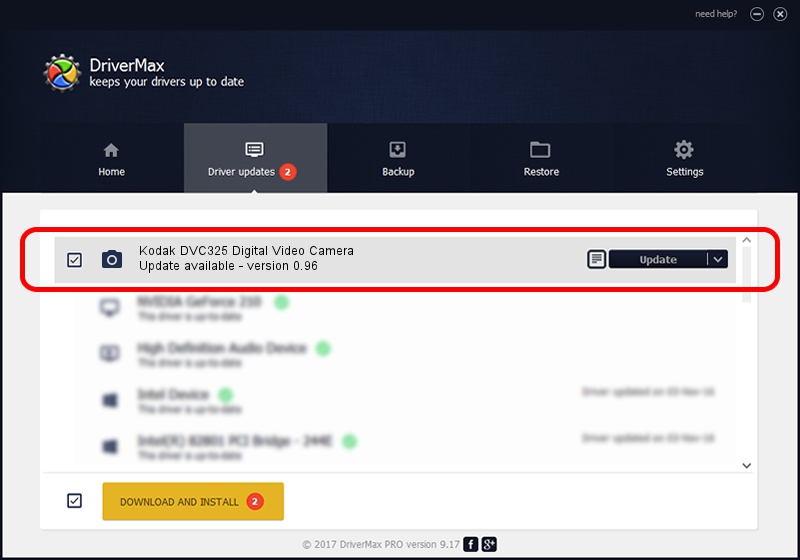
- #Kodak dvc325 digital video camera how to
- #Kodak dvc325 digital video camera movie
- #Kodak dvc325 digital video camera pro
- #Kodak dvc325 digital video camera iso
In 1983, Canon commissioned Luigi Colani to envision the future of camera design. At bottom is the HOMIC, aka the Horizontal Memorychip Integral storobo Camera. Luigi Colani's colorful camera concepts: From top left to right, there is the Hy-Pro, the Lady, the Super C Bio and the Frog. Colani's concepts: Almost the future of cameras Meanwhile, in October 1981 the digital revolution rolled on with the release of the world's first consumer compact disc player, the Sony CDP-101. What made the All-Sky Camera truly digital was that it recorded digital data rather than analog. The All-Sky Camera used more of those 100x100-pixel Fairchild CCDs, which had been around since 1973. The University of Calgary Canada ASI Science Team built the Fairchild All-Sky camera to photograph auroras in the sky. The first true digital camera that actually worked was built in 1981. Their ability to transmit images meant they were mainly used by newspapers to cover events such as the 1984 Olympics, the Tiananmen Square protests of 1989 and the Gulf War in 1991. These kinds of cameras never really took off, however, due to poor image quality and prohibitive cost. It cost $499 in the US, but consumers had to haul out another $999 on a battery, computer interface card with software, and floppy disks. The Xapshot was called Ion in Europe or Q-Pic in Japan.
#Kodak dvc325 digital video camera pro
That pro model was followed by a consumer model, the RC-250 Xapshot, in 1988.
#Kodak dvc325 digital video camera iso
The light sensitivity of the sensor was ISO 200, and the shutter speed was fixed at 1/60 second.Ĭanon launched the first analog electronic camera to actually go on sale, the RC-701, in 1986. CCD size was 570x490 pixels on a 10x12mm chip. Running off AA batteries, the Mavica stored pictures on two-inch floppy disks called Mavipaks holding up to 50 color photos for playback on a television or monitor. These analog electronic cameras were precursors to digital snappers in that they recorded images on to electronic media, but they were still technically recording analog data. Technically, the Mavica was a television camera that took still frames. However, it wasn't strictly a digital camera. This began in 1981 when Sony demonstrated a prototype Mavica (Magnetic Video Camera) model. The first cameras to use CCD sensors were specialist industry models made by Fairchild in the 1970s.īy the 1980s, handheld cameras began to ditch film.

A CCD is a light sensor that sits behind the lens and captures the image, essentially taking the place of the film in the camera. The charged-couple device (CCD), invented in 1969, was the breakthrough that allowed digital photography to take off. Mario Ruiz/The Life Images Collection via Getty Images So the next step in the process would come from elsewhere. Some say Kodak missed a trick by not developing this technological breakthrough, as it chose to continue to focus on photographic film. It also took 23 seconds to snap the first digital photograph.

Kodak's prototype had a resolution of 0.01 megapixel. Today's Apple iPhone 12 lineup has 12-megapixel cameras. It captured black-and-white images on a digital cassette tape, and Sasson and his colleagues also had to invent a special screen just to look at them.

The resulting camera, pictured in 2007 on its first trip to Europe, was the size of a printer and weighed nearly 4 kilograms.
#Kodak dvc325 digital video camera movie
He built a prototype ( US patent 4,131,919) from a movie camera lens, a handful of Motorola parts, 16 batteries and some newly invented Fairchild CCD electronic sensors. The first actual digital still camera was developed by Eastman Kodak engineer Steven Sasson in 1975. The first prototype digital camera, developed by Kodak's Steven Sasson. It wasn't until 15 years later that the digital camera became a reality. It was the same story 10 years later when Texas Instruments employee Willis Adcock came up with a proposal for a filmless camera ( US patent 4,057,830).

#Kodak dvc325 digital video camera how to
Lally actually figured out how to solve red eye in photos, but unfortunately his theory of digital photography was still way ahead of the existing technology.


 0 kommentar(er)
0 kommentar(er)
